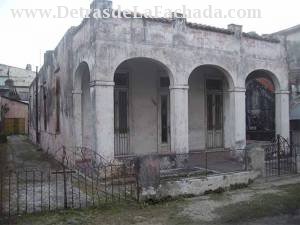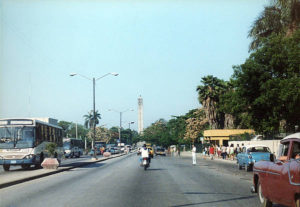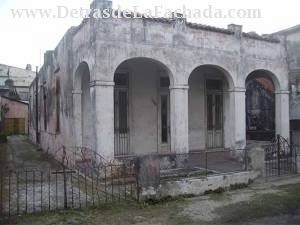Memories: MARIANAO “THE CITY WHICH PROGRESSES”. HISTORY.
We find interesting the story of the creation of one of the most popular of Marianao, Havana and where it begins its origin. This is the theme of our historical overview. There are several versions.
For some, it took the name of a ship wrecked on the coast, you know that “nao”, although it is a term of the Portuguese language, occasionally in cult language, is used to designate a boat or ship. The word “não” (from the latin navis ‘ship’) had in Spanish of centuries past, especially the 14th to the 17TH, the generic meaning of “ship” or “boat”, especially for those boats equipped with deck and sails, but not equipped with oars.
Among other speculations about the origin of the name, there is one that States that it was given by a Lady of Portuguese nation, called Mary and last name Navo. More than one joke would have generated if he is called Maria-navo…
Before these proposals, there is another that go to find information in references to official documents:
In the first found, from the 16th century, that refers to this town, is told “Mayanabo”. Apparently, Marya, Arabic is swamp and Abo, River. We could consider it logical if we take into account the characteristics of the locality, where out of the River to the sea, a vast swamp, where abundant mangrove is formed. The voice “Marya” and ending “Abo”, River, appear in countless texts, being even designated by Esteban Pichardo as meaningful of waters.
This swampy area is called “patabanal”, as well as swamps immediate, because it is virtually covered by mangrove of the species called “Pataban”. I guess that these areas would be cleared and missing to develop this territory, since they are not currently abundant
In some old documents, the river is called “Maxaguan” and the lagoon: “of the Junco”, although I know nothing about because they were so appointed. Today we know them as “Quibú” or quibus, the lagoon and the River, which still exists, name was apparently given by any owner in the area. Quibus is a surname of Spanish origin.
In the cabildo of 29 June 1675, appears the request of Don Jacinto de Pedroso and the greatest Lieutenant, Don Nicolás Castellón, so that do you a piece of land and Mount Mercy, between “Mayanabo” Brook, bordering on stay of such major ensign and stays of Jaimanitas, the return of North of the realengo, for repair of its Guatao and pipe corrals. In Exchange, by this concession they committed themselves to make the “Fiestas de San Marzal”, and pay the fee.
In 1730 the Licenciado Don Lucas Franco and Don Francisco Castellón Sheriff of the Holy Office, half of the five Guatao poultry owners leagues of this port, “.. .hicieron grace and grant to Don Juan Florez Rubio, piece of Brook, which belonged to them in the”Marianabo”, which goes to the sea, from the boundary of the land of el tejar was of Don Juan Recio Sotolongo;” with its margin and spills of Maxaguan, to the top calling Jaimanitas…”
History presents us with “Mayanabo” as a fruitful forest area at the beginning of the 17TH century, which for many years would have wood and firewood throughout the neighborhood of the former villa of San Cristóbal de La Habana.
We know that from newly founded the city of Havana some families were attracted by those places of brackish water cave and tangled mangroves, and there built their huts. Ensures that these settlers included a woman called María Navo, or turnip, received in merced, the Cabildo, the greater part of that territory. This woman, with firm resolve, proclaimed himself to guide and mentor to that group of men, thus forming the primitive village surrounded by lagoons Cayman, Guabinas and Quibu, the latter draining by the river of the same name.
At that time, French pirates noncompliant with the proceeds with his attacks on the high seas, also assaulted the towns of the coast and the “hamlet of María Navo”, which thus called on behalf of its owner, it was attacked and looted several times, forcing its inhabitants to hide in the jungle and to contemplate as the fire he devoured relentless their humble homes.
Sure, María Navo, a strong character and already tired with this situation, rebelled and ordered the construction on the coast, a strong tower to mount a permanent guard, with the cooperation of its neighbors, and to be able to watch day and night. The aforementioned Fort led to the promotion of a settlement, that is the genesis of the current Marianao, one of the 15 municipalities that make up the Cuban capital.
On a ledge of the coast, between the Quibu River and the beach of Marianao, still can be seen the remains of an old tower to which revolves around the history of the place. The Tower of Marianao became a defensive military construction, which supplemented the system of surveillance in Havana at the end of the 17TH century. It was built during the term of Governor José Fernández de Córdoba and authorised by Royal Decree of 15 June 1684.
Product of the inevitable development of the area, were blinded lagoons, channeling the River, filling in the bass, leveling the field, “perfecting” the work of nature, and began to rise modern spas and beautiful residences between avenues of pine trees.
Meeting on “The book of Cuba” in 1925…
“.. .A fabulous future awaits these neighboring places of the capital of the Republic to judging by its rapid growth and the waste of luxury with that, there are the Cuban rulers including some foreigners built their dwellings and are preparing to contribute to their greater embellishment.” “The Racecourse, aerodrome, the diamond of the Base Ball and the Court of the Basque Pelota, the Gran Casino de la Playa occupy nearby filling the rada sport boats and canoes of race, by which is not risky to predict that this place will be every day more visited by friends and strangers and will offer to the American tourist attractions…” all this made him to be called by its inhabitants and local authorities “the city that progresses”.
The truth is that the name of this territory habanero, undoubtedly arose thanks to the emigrant, possibly Portuguese, which one day arrived to the area attracted by the green of the vegetation and the singing of the birds. Result of its name and its commitment will emerge Marianao, name that will also take the River, beach and another town, Quemados de Marianao. In Matanzas, boasts it a lagoon or albufera, a tip of land immediately, and Nuevitas there are so-called Mayanabo a neighborhood and a stream.
Agencies/MemoriasCuba/DerubinJacome/InternetPhotos/Arnold Varona/TheCubanHistory.com
THE CUBAN HISTORY, HOLLYWOOD.
MEMORIAS: MARIANAO “La Ciudad que Progresa”. HISTORIA.
Encontramos interesante la historia de la creación de uno de los municipios mas populares de la Habana, Marianao y de donde comienza su origen. Este es el tema de nuestro resumen histórico. Hay varias versiones.
Para algunos, tomó el nombre de una nave naufragada en su costa, ya saben que “nao”, aunque es un término de la lengua portuguesa, en ocasiones, en lenguaje culto, se utiliza para designar una embarcación o nave. La palabra “nao” (del latín navis, ‘barco’) tuvo en el castellano de siglos pasados, sobre todo los siglos XIV al XVII, la acepción genérica de “nave” o “barco”, especialmente para aquellas embarcaciones dotadas de cubierta y velas, pero no dotadas de remos.
Entre otras especulaciones sobre el origen del nombre, hay una en que se afirma que le fue dado por una señora de nación portuguesa, llamada María y de apellido Navo. Más de una broma hubiera generado si se llamase Maria-navo…
Ante tales propuestas, no queda otra que irse a la búsqueda de información en las referencias de documentos oficiales:
En los primeros encontrados, del siglo XVI, en que se nombra esta localidad, se le dice “Mayanabo”. Al parecer, Marya, en árabe es pantano y Abo, Río. La podríamos considerar lógica si tenemos en cuenta las características de aquella localidad, donde a la salida del rio al mar, se forma un extenso pantano, en donde abunda el mangle. La voz “Marya” y la terminación en “Abo”, río, aparecen en infinidad de textos, siendo incluso señalada por Esteban Pichardo como significativa de aguas.
A esta zona pantanosa se le llama “patabanal”, así como a las ciénagas inmediatas, por encontrarse prácticamente cubiertos por mangle de la especie llamada “Pataban”. Supongo que estas áreas serían desbrozadas y desaparecidas al desarrollarse este territorio, ya que actualmente no son abundantes
En algunos documentos antiguos, al río le llaman “Maxaguan” y a la laguna: “del Junco”, aunque desconozco porque fueran así nombrados. Hoy les conocemos como “Quibú” o de Quibus, a la laguna y al rio, que aún existe, nombre que al parecer fue dado por algún propietario de la zona. Quibús es un apellido de origen español.
En el cabildo de 29 de Junio de 1675, aparece la solicitud de Don Jacinto de Pedroso y el Alférez Mayor, Don Nicolás Castellón, para que le hicieran merced de un pedazo de tierra y monte, entre el arroyo “Mayanabo”, lindando con estancia del dicho alférez mayor y estancias de Jaimanita, la vuelta del Norte del realengo, para reparo de sus corrales Guatao y el Cano. A cambio, por esta concesión se comprometían a hacer las “Fiestas de San Marzal”, y pagar los derechos.
En 1730 el Licenciado Don Lucas Franco y Don Francisco Castellón Alguacil del Santo Oficio, dueños por mitad del Corral Guatao cinco leguas de este puerto, “…hicieron gracia y donación a Don Juan Florez Rubio, del pedazo de arroyo, que les pertenecía en el “Marianabo”, que va a la mar, desde el lindero de la tierra del tejar que fue de Don Juan Recio Sotolongo; con su margen y derrames del de Maxaguan, hacia la parte de arriba que llaman Jaimanita…”
La historia nos presenta a “Mayanabo” como una fructífera área boscosa a principios del siglo XVII, la cual durante muchísimos años surtiría de madera y leña a todo el vecindario de la otrora villa de San Cristóbal de La Habana.
Sabemos que desde recién fundada la ciudad de La Habana algunas familias fueron atraídas por aquellos parajes de lagunatos salobres y enmarañados manglares, y allí levantaron sus bohíos. Se asegura que entre estos pobladores figuraba una mujer llamada María Navo, o Nabo, que recibió en merced, del Cabildo, la mayor parte de ese territorio. Esta mujer, con firme resolución, se proclamó guía y mentora de aquella agrupación de hombres, formando así el primitivo pueblo rodeado por las lagunas Caimán, Guabinas y Quibú, esta última desaguando por el río del mismo nombre.
En aquella época, los piratas franceses no conformes con lo obtenido con sus ataques en alta mar, también asaltaban los poblados de las costas y el “caserío de María Navo”, al que así llamaban en nombre de su dueña, fue atacado y saqueado varias veces, obligando a sus moradores a ocultarse en la manigua y a contemplar como el incendio devoraba implacable sus humildes hogares.
Según se asegura, María Navo, de carácter fuerte y ya cansada con esta situación, se rebeló y mandó a construir en la costa, un fuerte torreón donde poder montar una guardia permanente, con la colaboración de sus vecinos, y poder vigilar durante día y noche. El citado fortín motivó la fomentación de un asentamiento poblacional, que es la génesis del actual Marianao, uno de los 15 municipios que integran la capital cubana.
En un saliente de la costa, entre el rio Quibú y la Playa de Marianao, todavía pueden contemplarse los restos de un viejo torreón a cuyo alrededor gira la historia del lugar. El Torreón de Marianao llegó a ser una construcción militar defensiva, que complementaba el sistema de vigilancia en La Habana a finales del siglo XVII. Fue construido durante el mandato del Gobernador José Fernández de Córdoba y autorizado por Real Cédula de 15 de junio de 1684.
Producto del inevitable desarrollo de la zona, se cegaron las lagunas, encauzando el rio, rellenando los bajos, nivelando el terreno, “perfeccionando” la obra de la naturaleza, y comenzaron a levantarse modernos balnearios y preciosas residencias entre avenidas de pinos.
Encuentro en “El Libro de Cuba” de 1925…
“….Un porvenir fabuloso espera a estos lugares vecinos de la capital de la República a juzgar por su rápido crecimiento y por el derroche de lujo con que se instalan allí los potentados cubanos entre los cuales algunos extranjeros construyen sus moradas y se aprestan a contribuir a su mayor embellecimiento. El Hipódromo, el Aeródromo, el Diamante del Base Ball y la Cancha de la Pelota Vasca, el Gran Casino de la Playa ocupan los alrededores llenando la rada los barcos de sport y las canoas de regata, por lo cual no es aventurado predecir que este lugar será cada día más visitado por propios y extraños y ofrecerá al turista americano mayores atractivos…” todo esto le hizo ser llamado por sus habitantes y autoridades locales “la Ciudad que Progresa”.
Lo cierto es que el nombre de este territorio habanero, sin dudas surgió gracias a aquella emigrante, posiblemente portuguesa, que un buen día arribó a esta zona atraída por los verdes de la vegetación y el canto de las aves. Resultado de su nombre y su empeño surgirá Marianao, nombre que tomará también el río, la playa y otro pueblo, Quemados de Marianao. En Matanzas, lo ostenta una laguna, o albufera, y una punta de tierra inmediata, y en Nuevitas existen un barrio y un estero, denominados de Mayanabo.
Agencies/MemoriasCuba/DerubinJacome/InternetPhotos/Arnoldo Varona/TheCubanHistory.com
THE CUBAN HISTORY, HOLLYWOOD.










